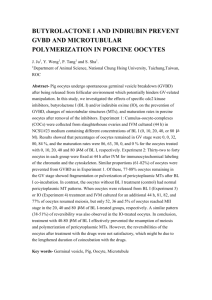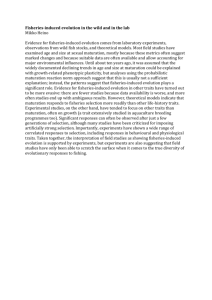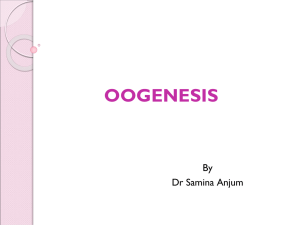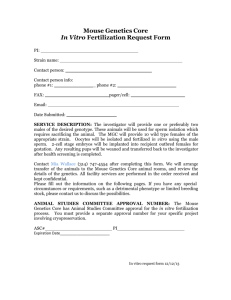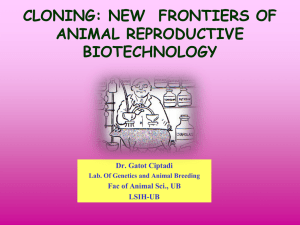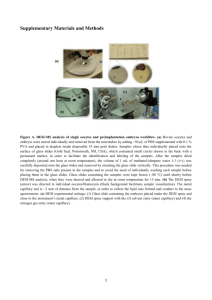Open Access version via Utrecht University Repository
advertisement
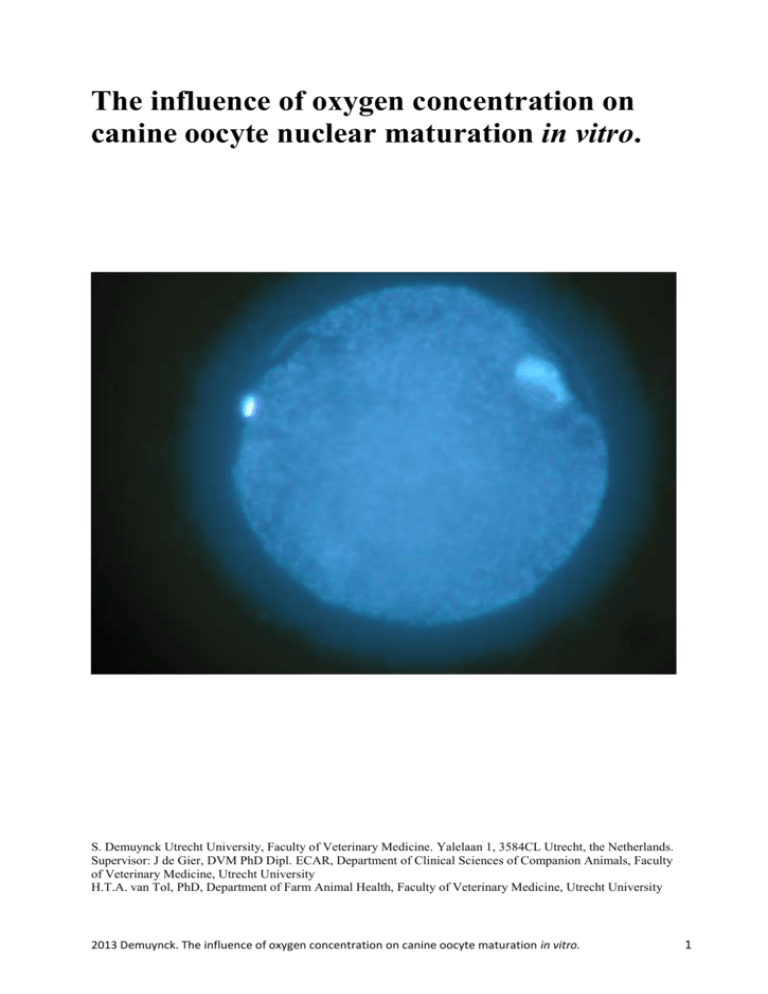
The influence of oxygen concentration on canine oocyte nuclear maturation in vitro. S. Demuynck Utrecht University, Faculty of Veterinary Medicine. Yalelaan 1, 3584CL Utrecht, the Netherlands. Supervisor: J de Gier, DVM PhD Dipl. ECAR, Department of Clinical Sciences of Companion Animals, Faculty of Veterinary Medicine, Utrecht University H.T.A. van Tol, PhD, Department of Farm Animal Health, Faculty of Veterinary Medicine, Utrecht University 2013 Demuynck. The influence of oxygen concentration on canine oocyte maturation in vitro. 1 Table of contents 1. Introduction 2. Material and methods 2.1. Collection of material 2.2. Determining the culture groups 2.3. In vitro maturation 2.4. Assessment of nuclear status 2.5 Statistical analysis 3. Results 4. Discussion 5. Proposal for further research 6. Acknowledgements References Appendix 1 Appendix 2 Appendix 3 3 7 11 13 15 15 16 18 19 21 Glossary GV GVBD MI MII COC D ND LH FSH P4 E2 SOF IVM IVF ROS RNS germinal vesicle germinal vesicle breakdown metaphase I metaphase II cumulus oocyte complex degenerated not definable luteinizing hormone follicle stimulating hormone progesterone oestradiol synthetic oviductal fluid in vitro maturation in vitro fertilization reactive oxygen species reactive nitrogen species 2013 Demuynck. The influence of oxygen concentration on canine oocyte maturation in vitro. 2 Abstract In this study the influence of oxygen concentration on the oocyte maturation in dogs was investigated. Ovaria were collected from 16 bitches undergoing elective ovariectomy and the cumulus oocyte complexes (COC) were collected. COC’s were matured in synthetic oviductal fluid (SOF) supplemented with luteinizing hormone (LH), follicle stimulating hormone (FSH) and progesterone (P4). 85 oocytes were cultured in group 1 in a humidified environment at 38.7°C, 5% CO2, 7% O2. 88 oocytes were cultured in group 2 in a humidified environment at 38.7°C, 5% CO2, 20% O2. After 72 hours of culture oocytes were stained with Hoechst 33342 and the nuclear maturation stage was determined. Oocytes were classified as germinal vesicle (GV), germinal vesicle breakdown (GVDB), metaphase I (MI), metaphase II (MII), degenerated (D) and not definable (ND). After 72h of culture, the percentages of oocytes still at the GV stage did not differ between both groups (7% O2, 20% GV vs 20% O2, 22% GV). However, the percentage of oocytes that had matured up to the MII stage was significantly (p<0.05) higher after culture in 7% O2 compared to culture 20% O2 (7.7% vs 0% respectively). It is concluded that maturation of canine oocytes in a low oxygen environment is beneficial for nuclear maturation. Key words: Canine; Oocyte; Oxygen; In vitro maturation 1. Introduction The dog is a mono-oestrous species, with an obligate period of anoestrus after each period of oestrus, averagely ovulating twice a year. Ovulation is preceded by a proestrus period varying between 3 – 17 days with an average of 9 days. Proestrus is characterized by swelling of the vulva and serosanguineal discharge from the vagina. The proestrus ends with the bitch being receptive for mating (Wildt et al 1978). The LH surge lasts an average of 3.5 – 4 days (fig 1), longer than what has been shown in most other mammals (Wildt et al 1978). Fig. 1 Fluctuating hormone levels during the proestrous, oestus and diestrous in the dog. (Senger) 2013 Demuynck. The influence of oxygen concentration on canine oocyte maturation in vitro. 3 Meiosis occurs exclusively in the gametes and is the cell division that prepares cells for reproduction. Meiosis is arrested at the prophase of the first meiotic division, characterized by the presence of a germinal vesicle (GV), until the appropriate hormonal stimulation triggers meiotic resumption. The GV, containing the nuclear material, breaks down this is the germinal vesicle breakdown (GVBD) stage. Nuclear material is released and the metaphase plate of the first meiotic division is created (MI). Homologue chromosome pares are separated and half of the nuclear material is ejected from the oocyte and the first polar body is created. Then the metaphase plate of the second meiotic division is formed this is the metaphase II (MII) stage (fig 2). Fig. 2 Nuclear maturation of oocytes. (Masui, 2000) The first registered account of artificial insemination was in a bitch in 1780 by Spallanzani (Spallanzani 1787). Since then, research progress concerning canine oocyte maturation has slowed down notably and the knowledge lacks behind that of other mammals. It is suspected that because of the unique circumstances during canine oocyte maturation, results of in vitro maturation (IVM) are disappointing and are characterized by high degeneration rates (>50%) and low metaphase II (MII) maturation rates (16,2%) (Rodrigues and Rodrigues 2010). As a consequence further development of assisted reproductive technology in canines is limited. Further research is needed to develop a suitable IVM environment for canine oocytes to mature. IVM can be beneficial for the saving of endangered species, and could save for example the African wild dog and the grey wolf on the verge of extinction. Canine oocyte maturation differs from maturation in other mammals. In dogs, an immature oocyte is ovulated, still in the prophase of the first meiotic division whereas in other mammals mature oocytes at the MII phase of nuclear maturation are ovulated. Oocyte maturation in the dog is completed in the oviduct 48-72 hours after ovulation (Tsutsui 1989). It has been confirmed by Reynaud et al. that up till 44 hours after ovulation all oocytes are still at the germinal vesicle (GV) stage. At 48 hours the first oocyte at metaphase I (MI) can 2013 Demuynck. The influence of oxygen concentration on canine oocyte maturation in vitro. 4 be present, however a notable difference in pace of maturation between oocytes from the same bitch has been described. After 48 hours, all stages of nuclear maturation can be observed simultaneously (Reynaud et al 2005). Mimicking the oviductal environment could be the key to IVM and eventually in vitro fertilization (IVF) in canines. In 1972 Trevit attempted to mimic the oviductal environment in order to develop ovine embryos beyond the 12-cell cleavage. He created a culture medium based on the chemical analyses of ovine oviductal fluid, synthetic oviductal fluid (SOF) (Trevit et al. 1972). His version of SOF contained 32% bovine serum albumin (BSA). Since then SOF has been adjusted to fit different requirements and has been used with positive results for in vitro embryo culture of rabbit, ewe, cow, monkey, human and mouse embryos (Hewitt et al. 1999). In other mammals oocytes mature in the follicular environment, where the concentration of reactive oxygen species (ROS) and reactive nitrogen species (RNS) have been noted to influence oocyte physiology both positively and negatively (Fujii et al. 2005). Luteinizing hormone (LH) reduces ascorbic acid, an antioxidant, in the preovulatory follicles. This could suggest that ROS plays its part in the final oocyte maturation (Ashutosh et al. 2010). This theory is further supported by results from an in vitro experiment with immature rat oocytes. In that study low levels of H2O2 induced meiotic resumption (Chaube et al 2005). In 1995 Eppig and Wigglesworth tested the effect of multiple oxygen concentrations on the developmental competence of mouse oocytes. They found that raising (above 5%) of the oxygen concentration was not only not promoting oocyte development, but it was actually detrimental, particularly during the earlier stages of oocyte development in vitro. Chaube et al (2005) showed that relatively high levels of H2O2 in M199, resulted in apoptosis and cell cycle arrest of rat oocytes (Chaube et al. 2005). Based on these results it could be hypothesized that low levels of ROS enhance meiotic maturation whilst high levels of oxygen, stimulating the production of ROS, can cause apoptosis and cell cycle arrest. For research purposes, canine ovaria are mostly retrieved from bitches undergoing elective ovariectomy. Therefore they shall most likely be in the anoestrus stage because most practices prefer to perform ovariectomy during anoestrus, starting 2-3 months after the last period of heat. Canine oocytes from anoestrus bitches have been proven to lack meiotic competence, which oocytes from other mammals do have, up to the LH peak (Chasant-Maillard et al. 2012). Therefore a culture mimicking solely the oviductal environment will probably not be sufficient to improve results of maturation to MII phase (Chasant-Maillard et al. 2012). IVM environments must thus mimic the follicular environment and the oviductal environment to enhance maturation results. This could be achieved by supplementing hormones in concentrations mimicking the presence of hormones in both environments. Oocytes retrieved from ovaria that are not receiving hormonal stimulation, as during the oestrus period which is mostly the case with an elective ovariectomy, have not been exposed to sufficient amounts of gonadotrophic hormones (Lee et al. 2007). Multiple protocols have been tested with hormone supplementation to enhance meiotic resumption and/or complete maturation of canine oocytes. For example Songsasen et al (2002) witnessed relatively high rates of GVBD after just 48 hours when LH had been added to the culture medium. Lee et al. (2007) showed that adding follicle stimulating hormone (FSH) to the culture medium enhances cumulus cell expansion. Intact cumulus cells and communication between cumulus cells has been proven to be of importance in the maturation of fox oocytes (Krogenaes et al 1993). During meiotic maturation inside the oviduct the cumulus cells 2013 Demuynck. The influence of oxygen concentration on canine oocyte maturation in vitro. 5 remain firmly attached to the oocyte until the morula stage (Renton et al 1991), suggesting the role of the cumulus cells is more important in the canine species than in other mammals. Research has been done concerning estrogen (E2) and progesterone (P4) supplementation to culture media. The supplementation of either E2 or P4 significantly stimulated oocyte maturation but supplanting E2 and P4 together yielded varying results, increasing or decreasing maturation rates (Kim et al. 2005). In this study we have chosen to investigate whether oxygen concentration influences the potency of canine oocytes to mature up to the MII phase. It was chosen not to fertilize the oocytes but stain them after 72 hours of culture to determine nuclear status. Oocytes were cultured in modified SOF (appendix 1) supplemented with LH, FSH and P4 for 72 hours in two different oxygen concentrations, 7% and 20%. It was hypothesised that a lower oxygen concentration will positively influences canine oocyte maturation. This positive influence can be measured by the amount of oocytes resuming meiosis, reaching MII and degenerating. 2013 Demuynck. The influence of oxygen concentration on canine oocyte maturation in vitro. 6 2. Material and Methods 2.1 Collection of material Ovaria were collected from local veterinary practices, where bitches were undergoing elective ovariectomy. The 29 bitches included in the study were of various breeds and the age of the bitches ranged from 6 months to 6 years. All bitches had to be healthy and these was no medical indication for sterilization. Material was collected in a thermos containing 0,9% NaCl supplemented with 0.1% penicillin and streptomycin (Gibco, Bleiswijk, The Netherlands) at 37°C. Age of the donor and onset of the last recorded period of heat were noted, if this information was available. After transportation ovaria were removed from the travel container and trimmed of their non-ovarian tissue. They were then placed on a glass slab for slicing. Cumulus-oocyte complexes (COCs) were released from ovaria by repeated slicing with a stamp-like tool containing multiple parallel blades. Sliced ovaria were placed in a 50ml tube with 5ml Hepes buffered TCM 199 (Gibco, Bleiswijk, The Netherlands), the remaining liquid on the glass slab was collected with a pipette and placed into the same 50ml tube. Material that remained attached to the glass slab was dissolved with Hepes buffered TCM 199, collected with a pipette and added to the content of the 50ml tube. This tube was then rolled for 10 minutes, whereafter the tube was left to rest for 5 minutes to enable the COCs to sink to the bottom. Ovaria were removed from the tube, with a forceps. The liquid content from the bottom of the tube was pipetted on a petri dish and examined under a microscope. All COCs were removed from this petri dish using a glass bore pipette and collected in 1 ml wash medium. All liquid was processed in this manner. After processing all the liquid in which the ovaria had been placed the COCs were counted. Because the size of culture groups is of influence on the potency of COCs to reach the MII phase only groups containing more than 12 COCs, at least 6 COCs per culture group, were used in this study. Ovaria that yielded less than 12 COCs were combined with COCs from other ovaria if this was logistically possible. When COCs from different dogs were combined they were first categorized as stated below before being combined, in this manner it was guaranteed that the COCs from different dogs were divided equally between the culture groups. If it was not possible to combine COCs from different dogs to create larger culture groups these COCs were placed in culture for varying sets of time. Results from these culture groups were not included in this research. Oocytes from the 0 hour group were used as GV reference for nuclear phase determination. 2.2 Determining the culture groups After collection of the COCs, they were divided into categories based on 3 different visible characteristics as depicted in fig 4. Briefly: - The first characteristic was cytoplasm diameter (fig 3.); the first category contained COCs with a cytoplasm diameter of 100µm or more, the second category contained COCs with a cytoplasm diameter of less than 100µm, the third category contained disintegrated, incomplete COCs or empty zona pellucida. - The second characteristic was presence of cumulus; the first category contained COCs with cumulus that surrounded the complete oocyte, the second category contained COCs with incomplete cumulus, the third category contained oocytes without any cumulus attached. 2013 Demuynck. The influence of oxygen concentration on canine oocyte maturation in vitro. 7 - The third characteristic was the colour of the cytoplasm; the first category contained COCs that had a black cytoplasm, the second category contained COCs that had a brown cytoplasm. COCs that were placed in the third category based on the first characteristic (disintegrated, incomplete or empty zona) were not included in further research. COCs that were placed in the same categories based on all three characteristics were considered equals and were divided equally between the two culture groups (fig. 4) aa 100µm b c c Fig 3. Photographs of cumulus oocyte complexes (COC) before in vitro maturation from three categories b according to the diameter characteristic distribution a) COC from category one; ≥ 100µm , b) COC from category two; ≤ 100µm , c) COC from category three, disintegrated. Fig. 4. Flow chart for the categorization of COCs. 2013 Demuynck. The influence of oxygen concentration on canine oocyte maturation in vitro. 8 2.3 In vitro maturation COCs were placed in culture less than two hours after the ovaria were removed from the bitches. The two groups were cultured in SOF (115.53 mM NaCl, 7.16 mM KCl, 1.19 mM KH2PO4, 0.74 mM MgSO4 · 7 H2O, 25.00 mM NaHCO3, 1.78 CaCl2 · 2 H2O). The SOF culture was supplemented with 5ng/µL progesterone, 0.01 IU/ml FSH and 0.01 IU/ml LH. The SOF medium was placed in the incubator at least one hour prior to adding of the COCs to the dish. The droplets contained 150µl medium and were adjusted to the appropriate amount after the addition of COCs. Ten µl of SOF medium was used per COC. The culture groups always contained ≥ 6 COC’s, therefore, the amount of medium per experimental group was always ≥ 60 µl. The culture drops with COCs were covered with paraffin oil to prevent evaporation. COCs from group 1 were placed in a humidified culture environment at 38,7°C and 20% oxygen 5% CO2, COC’s from group 2 were placed in a humidified culture environment at 38,7°C and 7% oxygen 5% CO2. Both groups were cultured for a period of 72 hours and then removed from the culture environment. 2.4 Assessment of nuclear status After 72 hours of culture COCs were removed from the culture environment and washed in PBS. COCs were then placed in a solution of, hyaluronidase 10µg/ml with trypsine EDTA (Gibco Bleiswijk, The Netherlands) and passed repeatedly through glass pipettes with reducing diameters to remove the cumulus cells. After removal of cumulus cells, the oocytes were washed in PBS and fixed and permeabilized in a solution of 4% (w/v) paraformaldehyde (Klinipath, Duiven, The Netherlands) with 0,2% Triton X-100 (Sigma, Saint-Louis MO, USA) in PBS for 10 minutes at room temperature. Oocytes were then stored in 500µL 1% paraformaldehyde in PBS at 4°C for further processing. One ml of water was placed between the wells to prevent evaporation. Before nuclear staining the oocytes were washed in PBS. Subsequently they were placed in 10µg/ml Hoechst 33342 (Sigma, Saint-Louis MO, USA) in PBS for 10 min at room temperature in a dark environment. In groups of 4 or 5, the oocytes were removed from Hoechst 33342 dilution and placed on glass slides in 8µl Vectashield (Vector Labs Burlingame CA, USA) . The slides were then covered with a coverslip supported by Vaseline and sealed with nail polish. The meiotic stage of the oocytes was examined under a fluorescence microscope with a 355-nm wavelength excitation filter. The different stages of meiosis were classified and oocytes were categorized accordingly. The different phases were categorized according to Hewitt (Hewitt et al 1999) slightly adjusted (fig 5) but no distinction was made between anaphase I and metaphase I. All oocytes were photographed and labelled. Nuclear stages of the oocytes were divided into germinal vesicle (GV), germinal vesicle breakdown (GVBD), metaphase I (MI), metaphase II (MII), degenerated (D) and not detectable (ND). 2013 Demuynck. The influence of oxygen concentration on canine oocyte maturation in vitro. 9 a b c d Fig. 5 Photos of oocytes after 72 hours in vitro maturation stained with Hoechst, assessment of nuclear maturation. a) GV; b) GVBD; c) MI; d) MII. Table 1. Determination of nuclear phase Phase GV GVBD MI MII Degenerated DNA material spherical Yes No No No No DNA material condensed No No Yes Yes Possible Polar body present No No No Yes Possible DNA material present Yes Yes Yes Yes Possible GV, germinal vesicle; GVBD, germinal vesicle breakdown; MI, metaphase I; MII, metaphase II. Characteristics used for determination of nuclear phase for examination with immunofluorescence microscope. 2.5 Statistical analyses All differences between culture groups were determined by the use of a Chi-square test. P < 0.05 was considered significant. For calculations see appendix 2013 Demuynck. The influence of oxygen concentration on canine oocyte maturation in vitro. 10 3 Results A total of 31 dogs were included in this study, from which the ovaria the cumulus oocyte complexes were harvested by slicing the ovaria repeatedly. Two dogs were excluded from the research because the ovarectomy was not elective, those dogs were operated because of a medical indication. Of the remaining 29 dogs, the ovaria were used and the COCs were retrieved. This resulted in an average of 9,4 COCs per two ovaria. The highest number of COCs harvested was 68 (8 month old bitch), these ovaria had a purple appearance and were the size of a kidney bean. Multiple times only 1 or 2 COCs were harvested, these bitches most likely had their last period of heat 2-3 months ago and the ovaria were pale-white and small, it was suspected that these bitches were in anoestrus. a b Fig. 7. Photos of ovaria after removal of excessive tissue and before slicing. a) ovaria of a suspected anoestrus bitch, b) ovaria of a bitch suspected to be in oestrus. Of the 29 dogs, ovaria from 16 dogs were used for culture. Mainly because of the requirement that cultures must contain at least 6 COCs, it was not always logistically possible to combine COCs from different dogs because of the time restrictions. After culture the cumulus cells were removed, whereafter the oocytes were permeabilized and stained for nuclear examination. During these processes oocytes were damaged and could not be placed on a slide, and therefore the nuclear status of these oocytes could not be determined. In the experiment of Rota and Cabianca (2004) 37,6% of oocytes were reported to have been lost during procedures. In the 7% and 20% group there was an loss of 29.75% and 29.04% respectively of the oocytes after processing. Chi squared gave a P value of 0.752-1.000. A significant difference of loss between the 7% oxygen group and the 20% oxygen group was not seen. Table 2. Table 2. Effect of oxygen concentrations on oocytes lost after culture during processing. Culture environment 7% O2, 5% CO2 20% O2, 5% CO2 # Oocytes T=0 121 124 # Oocytes after processing 85 70,25% 88 70,96% Review of oocytes lost after removal from culture. Oocytes before culture, oocytes after processing and percentage of oocytes remaining after processing. All oocytes were scored according to the characteristics described earlier. They were divided into GV, GVBD, MI, MII and D. Unfortunately due to some technical difficulties that occurred during removal of cumulus cells, fixating and staining of the oocytes, it was not 2013 Demuynck. The influence of oxygen concentration on canine oocyte maturation in vitro. 11 possible to determine the nuclear status of all oocytes. Those that were not determinable (ND) were categorised as such. (appendix 3) Table 3. Effect of oxygen concentration on canine oocyte maturation. Medium #oocytes 7% O2, 5% CO2 85 20% O2, 5% CO2 88 Nuclear status GV GVBD 13 1 15,85% 1,22% 16 1 18,18% 1,14% MI 16 19,51% 14 15,41% MII 5 6,10% 0 0% D 30 36,59% 43 48,86% ND 20 24,39% 14 15,91% GV, germinal vesicle; GVBD, germinal vesicle breakdown; MI, metaphase I; MII, metaphase II; D, degenerated; ND, not definable. In both groups non definable oocytes were found, this was due to technical errors and not to the quality of the oocytes. It can therefore be assumed that the nuclear status of these oocytes could be any of the categories above, most likely relatively divided according to what was found in the definable oocytes. Therefore it has been chosen to calculate the significance of the differences between the culture groups without the ND category. Table 4. Effect of oxygen concentration on canine oocyte maturation, only of definable oocytes. Medium 7% O2, 5% CO2 #oocytes No ND 65 20% O2, 5% CO2 74 Nuclear status GV GVBD 13 1 19,99% 1,54% 16 1 21,62% 1,35% MI 16 24,62% 14 18,92% MII 5* 7,69% 0* 0% D 30 46,15% 43 58,11% GV, germinal vesicle; GVBD, germinal vesicle breakdown; MI, metaphase I; MII, metaphase II; D, degenerated The 7% and 20% culture groups were compared according to three variables. The number of oocytes reaching metaphase II (MII), the number of oocytes that resumed meiosis (MII, MI, GVBD) and the number of degenerated (D) oocytes, as seen in other literature. A total of 5 (MII) oocytes was found during this study, all of them were found in the 7% culture group. Calculated with Chi-squared this gave p = 0.02 – 0.01, the difference was significant. A higher percentage of meiotic resumption was found in the 7% oxygen group compared to the 20% oxygen groups but this difference was not proven to be significant (p = 0.15-0.10). A tendency to a higher rate of degeneration was found in the 20% oxygen group compared to the 7% oxygen group but this was not a significant difference (p = 0.20 – 0.15). 2013 Demuynck. The influence of oxygen concentration on canine oocyte maturation in vitro. 12 4 Discussion Ovaria were collected from veterinary practices in the circumjacent area, in a warm thermos containing a warm saline solution. Ovaria remained in this thermos for a maximum period of 25 minutes before being transferred to the glass slab. Slicing was performed at room temperature and Hepes TCM 199 had also been brought to room temperature. Searching of COCs took place on a heated table. In this way it was achieved that there was no cooling down of the COC’s below room temperature. In the article of Tas et al. (2006) different manners of transport were compared. They found that transport at a temperature of 4°C was beneficial for ovaria and yielded better maturation results. However their time for transport was 2 - 4 hours, which is at least quadruple of the maximum time in the here presented study. Because frequent contact was kept with the participating veterinary practices it was possible to collect the ovaria 5-10 minutes after removal from the dog. By placing them in warm saline almost immediately after removal, large temperature fluctuations were prevented. It was assumed that a temperature drop to 4°C for such a short period of time would not be beneficial to the oocytes. The collection of COCs was performed by slicing. Other methods that were described include puncturing of the follicles and pulverizing the ovaria. Because not all ovaria were collected from oestrus bitches the size of the follicles was too small to puncture. Pulverizing of the ovaria was rarely described in literature and experience with this method at the laboratory was minimal, therefore it not considered as an option. In this research we developed a more select way to categorize the COCs before placing these into culture. It was found that methods described in literature did not sufficiently incorporate all characteristics, which were thought to have influence on potency of oocytes to mature. In this new method colour of the cytoplasm, diameter of the oocyte and presence of cumulus were included. It was chosen to mimic the oviductal environment with SOF containing 0,4% BSA. BSA in the culture medium of canine COCs was shown to have positive results on IVM, by reducing the percentage of degenerated oocytes. (Hewitt et al 1998.) Alternatively, the oviductal environment is mimicked, for example by co-culture with oviductal epithelial cells. In the experiment of Hewitt et al. (1999) ovaria were removed from the bitch together with the oviducts and oviductal epithelial cells were collected. COCs were cultured in drops of modified 199 supplemented with epithelial cells. They concluded that culture with oviductal epithelial cells did not have an effect on oocyte maturation, no oocytes were seen undergoing germinal vesicle breakdown (GVBD) after 48 hours (Hewitt et al. 1999). Because in our study not all used ovaria were collected with the oviducts and because earlier studies showed no positive effect of co-culture with epithelial cells it was chosen not to use this method to mimic the ovarian environment. Progesterone has different effects on oocyte maturation in various mammals. High levels of progesterone can induce meiotic arrest in the mouse, but can improve the ratio of oocytes from rhesus monkeys reaching MII (Kim et al. 2005). Addition of progesterone to IVM medium of COCs retrieved from dogs in the anoestrus stage or luteal stage of their cycle improved maturation rates to MII. The results of oocytes collected from dogs in oestrus yielded maturation rates that were always higher compared to results from bitches in anoestrus or luteal stage (Kim et al. 2005). The concentration of progesterone that improved the maturation varied between different cycle stages, oocytes retrieved from the follicular phase needed higher concentrations. 2013 Demuynck. The influence of oxygen concentration on canine oocyte maturation in vitro. 13 It has been shown that COC density in culture media can influence the meiotic resumption. Culture groups of 10 COCs per 100µL had a significantly lower number of oocytes that remained in germinal vesicle stage, compared to 15 or 20 COCs in 100µL. This was only observed in cultures of COCs harvested from anoestrus bitches (Otoi et al. 2002). Because most of the COCs used in the here presented study were assumed to be collected from bitches which had had their last period of heat 2-3 months ago these bitches were considered as anoestrus. A ratio of 1 COC per 10µL of culture was chosen for COCs from anoestrus bitches. However, the precise cycle stage of the bitches was not determined during this research because the bitches were brought in for an elective ovariectomy and no further investigation was done. Removal of the cumulus was first attempted solely by vortexing for three minutes, this did not provide the desired results. Oocytes were still surrounded by cumulus cells, which was not preferable for assessment of the nuclear status. Therefore it was decided to test the method described in multiple articles (Vannucchi 2006, Saikhum 2008, Rota 2004). This method consisted of placing COCs in hyaluronidase for several minutes and then passing them repeatedly through glass pipettes until all cumulus cells were removed. This method had the desired effect directly and only oocytes of poor quality who showed degeneration after maturation were lost in the process. This also had the advantage that no oocytes of good quality could be lost in the vortexing process in which oocytes had to be transferred to and from different tubes. It was chosen to use this method of cumulus removal for the remaining duration of the experiment. After denudation the oocytes were permeabilized by placing them in a solution of 1% Triton X-100 in 4% paraformaldehyde for 10 minutes at room temperature. For logistical reasons some groups of oocytes were placed in 1% paraformaldehyde in the fridge for 24 to maximal 110 hours where after they were stained with Hoechst according to standard protocol used during this research for all oocytes. During examination of nuclear status it was noticed that oocytes that had been stained immediately after permeabilization in Triton X-100 were less clearly visible, and their nuclear status more difficult to determine, than those which had temporarily been stored in paraformaldehyde 1%. It was not possible to determine the precise improvement of Hoechst staining, neither was it possible to investigate this discovery any further. For the purpose of continuity it was chosen to store all oocytes in paraformaldehyde 1% temporarily. This is an interesting phenomenon which could benefit the determination of nuclear maturation if the exact effect and method to achieve this could be determined. Difficulties were encountered during the examination of oocytes after 72 hours of culture and staining with Hoechst. During the initial experiments it was attempted to solely vortex the oocytes to remove the cumulus, but this was not sufficient. Large numbers of cumulus remained on the oocytes after vortexing and made it difficult to determine the nuclear status. This was because a clear view of the nuclear material was not possible and the detection of a polar body was difficult. All oocytes with too much cumulus present to define the nuclear status were categorized as ND. After the process of cumulus removal had been modified, to the use of hyaluronidase, the nuclear material was clearly visible but determination of nuclear status remained difficult. Hewitt et al. (1999) developed a set of parameters to define the nuclear maturation status of canine oocytes. His parameters included the presence of a distinctive nucleolus surrounded 2013 Demuynck. The influence of oxygen concentration on canine oocyte maturation in vitro. 14 by fine filaments of chromatin in the immature germinal vesicle stage. However the distinct nucleolus characterizing the GV as stated by Hewitt was not always detected. For verifying purposes a number of oocytes were placed in culture for variable sets of time. The culture times used were 0h, 24h, 48h and 96h. The results of these experiments were not included in this research because the culture groups did not meet the set requirements. The oocytes from these experiments were stained with Hoechst and examined under the immunofluorescence microscope to determine nuclear status. Oocytes from the 0h group were used as a reference for the characteristics of a nucleus in the GV phase. None of these oocytes, which were unambiguously GV, did have a visible nucleolus. The most definable characteristic found in all GV in this experiment was the spherical orientation of the nuclear material. A modified of characteristics to define nuclear maturation was set up using what was observed during this experiment. It remained difficult to determine the difference between GV and MI in some cases. This because only the 2D image could be seen using a immunofluorecent microscope while the oocyte is spherical. In this study, COCs from different bitches were sometimes combined in one culture, where after it was not possible to determine the origin of the oocytes. Because the oocytes from different bitches were equally divided between the two culture groups it was expected that this would not influence the results. This did however cancel out the option to link oocyte maturation rates back to individual bitches. In the experiment of Songsasen et al (2002) great differences were seen in oocyte competence between different bitches independent of cycle stage. Suggestions for further research Oocytes are collected by slicing from follicles that have not received the proper preovulatory hormone stimulation. A biphasic culture environment mimicking the follicular phase and then the oviductal environment could be the key. Both environments must be mimicked taking in mind different hormonal and oxygen levels. Acknowledgements I would like to thank all veterinary practices that participated in my research. Without them this study could not have been conducted. o Dierenkliniek Oog in Al o Dierenkliniek Vossegat o Dierenkliniek Leidscherijn o Universiteits Kliniek voor Gezelschapsdieren o Dierenkliniek de Bilt o Dierenkliniek Dijkshoorn o Dierenkliniek Kerkebosch 2013 Demuynck. The influence of oxygen concentration on canine oocyte maturation in vitro. 15 References Chasant-Maillard, S., Saint-Dizier, M., Grimard, B., Chebrout, M., Thoumire, S., Reynaud, K., 2012. Are oocytes from the anoestrus bitch competent for meiosis? Reprod Dom Anim 47 (suppl. 6), 74-79. Chaube, S.K., Prasad, P.V., Thakur, S.C., Shrivastav, T.G., 2005. Hydrogen peroxide modulates meiotic cell cycle and induces morphological features characteristic of apoptosis in rat oocytes cultured in vitro. Apoptosis vol. 10 No. 4 863-874. Eppig, J.J., Wigglesworth, K., 1995. Factors effecting the developmental competence of mouse oocytes grown in vitro: Oxygen concentration. Molecular Reproduction and Development 42, S 447-456. Fujii, J., Iuchi, Y., Okada, F., 2005. Fundemental role of reactive oxygen species and protective mechanisms in the female reproductive systems. Reprod Biol Endocrinol 3:43-52 Hewitt, D.A., England, G.W.C., 1999. Synthetical ociductal fluid and oviductal cell coculture for canine oocyte maturation in vitro. Animal Reproduction Science 55 (1999) 6375. Kim, M.K. Oh, H.J., Fibrianto, Y.H., Jang, G., Kim, H.J., Hossein, M.S., Lee, E.S., Kang, S.K., Lee, B.C. and Hwang, W.S., 2006. Development of canine synthetic oviduct fluid (cSOF) medium and effect of the cSOF in in vitro nuclear maturation of canine oocytes. Reprod. Fertil and Devel. 18(2) 273-273. Kim, M.K., Fibrianto, Y.H., Oh, H.J., Jang, G., Kim, H.J., Lee, K.S., Kang, S.K., Lee, B.C., Hwang, W.S., 2005. Effects of estradiol-17β and progesterone supplementation on in vitro nuclear maturation of canine oocytes. Krogenaes, A.K., Nagyova, E., Farstad, W., Hafne, A.L., 1993. In vitro maturation of blue fox oocytes and cAMP production in oocyte-cumulus cell complexes. Theriogenology 39, 250 (abstract). Lee, H.S., Seo, Y.I., Yin, X.J., Cho, S.G., Kim, N.H., Cho, S.K., Kong, I.K. 2007. Effect of follicle stimulation hormone and luteinizing hormone on cumulus cell expansion and in vitro nuclear maturation of canine oocytes. Masui, Y., 2000. The elusive cytostatic factor in the animal egg. Nature Reviews Molecular Cell Biology 1, 228-231 (December 2000). H.J. Oh, Fibrianto, Y.H., Kim, M.K., Jang, G., Hossien, M.S., Kim, H.J., Kang, S.K. Lee, B.C., Hwang, W.S., 2005. Effects of canine serum collected from dogs at different estrous cycle stages on in vitro nuclear maturation of canine oocytes. Zygote 13 (August), pp 227232. Otoi, T., Willingham, L., Shin, T., Kreamer, D.C., and Westhusin, M., 2002. Effects of oocyte culture density on meiotic competence of canine oocytes. Reproduction. 124, 775-781. 2013 Demuynck. The influence of oxygen concentration on canine oocyte maturation in vitro. 16 Pandey, A.N., Tripathi, A., PremKumar, K.V., Shrivastav, T.G. and Chaube, S.K., 2010. Reactive oxygen and nitrogen species during meiotic resumption from diplotene arrest in mammalian oocytes. Journal of biochemistry, 111:521-528 Renton, J.P., Boyd, J.S., Eckersall, P.D., Ferguson, J.M., Harvey, M.J.A., Mullaney, J., Perry, B., 1991. Ovulation, fertilization and early embryonic development in the bitch. (Canis familiaris). Journal of reproduction and fertility 93 221-231. Reynaud, K., Fontbonne, A., Marseloo, ., Thoumire, S., Chebrout, M., Viaris de Lesengo, C., Chasant-Maillard, S., 2005. In vivo meiotic resumption, fertilization and early embryonic development in the bitch. Reproduction 130, 193-201. Rodrigues and Rodriques., 2010. In vitro maturation of canine oocytes: a unique conundrum. Animal Reproduction 7 3-1 Rota, A., Cabianca, G., 2004. In vitro maturation rates of canine oocytes from anoestrus bitches in simple media. Reprod. Nutr. Dev. 44 (2004) 105-109. Saikhun, J., Sruissadaporn, S., Thongtip, N., Pinyopummin, A., Kitiyanant, Y., 2008. Nuclear maturation and development of IVF/IVM canine embryos in synthetic oviductal fluid or in co-culture with buffalo rat liver cells. Theriogenology 69, 1104-1110. Songsasen, N., Yu, I., Leibo, S.P., 2002. Nuclear maturation of canine oocytes cultured in protein-free media. Molecular reproduction and development 62:407-415. Spallanzani, M., 1787. Expériences pour servir a l’histoire de la génération des animaux et des plantes. Trevit, H.R., Whittingham, D.G., Rowson, L.E.A., 1972. Succesful culture in vitro of sheep and cattle ova. J. Reprod. Fertil. 30, 493-497. Tsutsui, T., 1989. Gamete physiology and timing of ovulation and fertilisation in dogs. J. Reprod. Fertil. 39, 269-275, Suppl. Vannucchi, C.I., Motos de Oliveira, C., Groke Marques, M., Ortiz Avila Assumpcao, M.E., Visintin, J.A., 2006. In vitro canine oocyte nuclear maturation in homologous oviductal cell co-culture with hormone-supplemented media. Theriogenology 66, 1677-1681 Wildt, D.E., Chakraborty, P.K., Banko, W.B., Seager, S.W.J., 1978. Relationship of reproductive behaviour, serum luteinizing hormone and time of ovulation in the bitch. Biology of reproduction 18, 561-570. . 2013 Demuynck. The influence of oxygen concentration on canine oocyte maturation in vitro. 17 Appendix 1. SOF A Protocol Utrecht University Lot nr. LAL water Cambrex 200 ml NaCl Sigma 1.5725 g KCl Sigma 0.1335 g KH2PO4 Sigma 0.0405 g Na Lactate (60%) Sigma 150 µl MgSO4.7H2O Merck 0.0455 g NaHCO3 Sigma 0.525 g CaCl2.2H2O Sigma 0.0655 g Phenolred Sigma 125 µl MEM NEAA Sigma 2.5 ml BME AA Sigma 5 ml SOF B Protocol Utrecht University Lot nr. LAL water Cambrex 20 ml Pen/Strep Gibco 100 µl Na-Pyruvate Sigma 0.0036 g* L-Glutamine Sigma 0.030 g BSA Celliance 0.40 g 2013 Demuynck. The influence of oxygen concentration on canine oocyte maturation in vitro. 18 Appendix 2. Statistical analyses Completion of maturation (MII) (fig. 1) H0 = The proportion of oocytes that matured to MII was independent of oxygen concentration. H1 = The proportion of oocytes that matured to MII was associated with oxygen concentration. MII MII not MII Total found 7% 5 60 65 expected 5 60 0 74 2 63 3 71 20% 0 74 74 Total 5 134 139 F-E (F-E)^2 /E 2,661871 7,085555 3,030437189 -2,66187 7,085555 0,113076015 -2,66187 7,085555 2,661870504 2,661871 7,085555 0,099323526 5,904707233 Fig. 1 5,9047 in the Chi-squared table with 1 degree of freedom results in a significance of 0.020.01. The H0 must now be rejected and H1 is accepted; There is a significant difference. Meiosis resumption (GVBD + MI + MII) (fig. 2) H0 = The proportion of oocytes that resumed meiosis was independent of oxygen concentration H1 = The proportion of oocytes that resumed meiosis was associated with oxygen concentration. 2013 Demuynck. The influence of oxygen concentration on canine oocyte maturation in vitro. 19 MII + MI + GVBD 7% 22 43 65 MII,MI,GVBD no meiosis totaal found 22 43 15 59 expected 17 48 20 54 20% totaal 15 37 59 102 74 139 F-E 4,697842 -4,69784 -4,69784 4,697842 (F-E)^2 22,06972 22,06972 22,06972 22,06972 /E 1,275547047 0,462698439 1,120412946 0,406424304 3,265082736 Fig. 2 3,2651 in the Chi-squared table with 1 degree of freedom results in a significance of 0.150.10. The H0 must be accepted, there is no significant difference. Degeneration of oocytes (D) (fig. 3) H0 = The proportion of oocytes degenerating was independent of oxygen concentration. H1 = The proportion of oocytes degenerating was associated with oxygen concentration. D D niet D totaal 7% 30 35 65 20% totaal 43 31 74 found expected F-E 30 34 -4,136690647 35 31 4,136690647 43 39 4,136690647 31 35 -4,136690647 73 66 139 (F-E)^2 17,11220951 17,11220951 17,11220951 17,11220951 /E 0,501285 0,554452 0,440318 0,487018 1,983073 Fig. 3 1.9830 in the Chi-squared table with 1 degree of freedom results in a significance of 0.200.15. The H0 must be accepted, there is no significant difference. 2013 Demuynck. The influence of oxygen concentration on canine oocyte maturation in vitro. 20 Appendix 3. # Date Practice 3 14jan Vosse 4 14jan Dijks. 6 21jan 7 24jan UKG 2 Bowy Leids r 8 25jan Leids r 1 Amber Leids r 3 1 25jan 0 1 25jan Leids r 5 2 1 30jan UKG1 7 Cayla 1 31jan Vosse 9 2 31jan UKG 1 0 Inza 2 31jan UKG 2 1 Saartje 2 5 feb De bilt 2 2 11 Dijks. 3 feb 2 18 UKG 1 6 feb Muffin 2 18 UKG 2 7 feb Dunja 2 18 UKG 3 8 feb Indy Totaal/Average # Age Heat date tota l Cells t=0 5%20% Cells T=72 5% 20% MII 5% 20% 14/03 /11 3jr 20/11 /2012 ?? 15 (25) 10 ^ 13 12 0 ^^ 12 100 ^^ 0 ^^ 13 100 ^^ ^^ ^^ 29/10 /2011 10/11 /2011 12/07 /2012 18/01 /2011 18/05 /2012 ?? 28 14 14 0 27 13 14 17 8 9 2 22,22 0 0 ?? ?? 15 (18) 3 ^ 9 9 0 ^^ ^^ 6 42,85 6 42,85 8 88,89 7 77,78 ^^ 0 ?? 9 64,29 9 69,23 6 75 3 33,33 ^^ 38 19 19 5 (23) 18 ^ 11 12 ^^ ^^ 16 84,21 9 81,82 ^^ 12 6 6 17 8 9 17 8 9 10 (23) 8^ 12 11 ^^ 5^ 245 29/01 /2012 31/10 /2009 25/02 /2012 ?? 28/10 /2012 ?? 22/12 /2012 15/10 /2012 23/01 /2012 05/11 /2012 MI 5% 20% GVBD 5% 20% GV 5% 20% D 5% 20% ND 5% 20% 2 15,38 ^^ 3 25,00 ^^ 0 0 4 30,78 ^^ 1 8,33 ^^ 3 23,08 ^^ 2 16,67 ^^ 4 30,78 ^^ 6 50 ^^ ^^ ^^ 0 1 11,11 1 11,11 2 33,33 0 0 0 0 0 0 0 ^^ ^^ ^^ 1 16,67 1 16,67 3 37,5 1 14,29 ^^ 4 44,44 2 22,22 2 33,33 1 33,33 ^^ 5 83,33 2 33,33 3 37,5 4 57,14 ^^ 2 22,22 2 22,22 2 33,33 2 66,67 ^^ 0 0 2 22,22 1 11,11 0 1 11,11 0 0 ^^ 2 33,33 1 12,4 2 28,57 ^^ ^^ ^^ 12 63,16 12 100 ^^ 1 6,25 0 0 ^^ 6 37,50 3 33,33 ^^ 4 33,33 1 8,33 ^^ 0 0 ^^ 1 8,33 ^^ 5 41,67 2 16,67 ^^ 5 31,25 3 33,33 ^^ 3 25,00 5 41,67 ^^ 1 6,25 3 33,33 ^^ 0 0 3 18,75 0 ^^ 2 33,3 7 77,78 6 ^^ 3 50 2 25 5 62,5 10 83,33 ^^ 0 0 0 0 0 0 0 0 0 0 0 0 0 0 0 0 0 10 90,91 ^^ 2 20,00 ^^ 0 1 10,00 ^^ 0 0 ^^ 1 10,00 ^^ ^^ ^^ 1 50,00 1 20,00 1 10,00 ^^ 2 66,67 0 ^^ 3 60,00 5 50,00 ^^ 1 50,00 6 85,71 4 66,67 8 80,00 ^^ 1 33,33 1 50,00 1 20,00 1 10,00 ^^ 0 0 1 50,00 1 14,29 1 16,67 0 0 ^^ ^^ ^^ ^^ ^^ ^^ ^^ ^^ ^^ ^^ ^^ ^^ ^^ ^^ ^^ ^^ 121 124 85 70,25 88 70,96 5 6,10 0 0,0 16 19,51 14 15,41 1 1,22 1 1,14 13 15,85 16 18,18 30 36,59 43 48,86 20 24,39 14 15,91 0 0 2013 Demuynck. The influence of oxygen concentration on canine oocyte maturation in vitro. 21 ^^ 1 16,67 1 12,5 0 ^^ 3 25,00 ^^ 0 1 16,67 1 10,00 ^^

